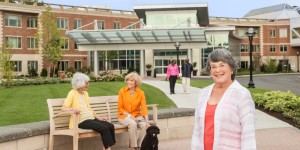Bottom Line: Land value, expertise in operations and maintenance of the communities will play a key role in Senior Housing, says Colliers Research.
 As Asian countries address the new realities of ageing crisis and increasing life expectancy, senior living is now becoming a next bet for investors. According to recently released Colliers Research report on Senior Housing Outlook 2018, countries such as Japan have grappled with an ageing population for some time, others are just beginning to realise that they will need to act quickly in order to address ageing-related issues.
As Asian countries address the new realities of ageing crisis and increasing life expectancy, senior living is now becoming a next bet for investors. According to recently released Colliers Research report on Senior Housing Outlook 2018, countries such as Japan have grappled with an ageing population for some time, others are just beginning to realise that they will need to act quickly in order to address ageing-related issues.
Macau and Singapore, for example, will see their senior populations skyrocket by 301% and 195%, respectively, by 2050. Even fast-developing countries where seniors are a smaller presence, such as India and the Philippines, will face difficulties, if many of their young people continue to work overseas and are largely unable to attend to the immediate needs of elderly parents.
In such scenarios, more infrastructure will be needed to cater to rising number of seniors who will be residing independently and are in need of different degrees of daily assistance and medical care.
“Few factors in Indian scenario such as concern in maintenance of properties during retirement days, restricted income source for seniors, rising crime rate against elderly people, emotional challenges such as lack of companionship and security, and other healthcare aspects should drive the need for senior housing in India in coming days. However, the market will take its own time to adopt the trend, considering the Indian system of living”, says Ravi Ahuja, Senior Executive Director, Mumbai & Developer Services at Colliers International India.
As per Census of India, 2011, India had about 98 million elderly citizens, which are likely to grow in future. Also, the overall life expectancy is also on the rise giving the urge to address retiree’s demand in the country.
According to Colliers Research, the major senior housing categories that have emerged this far can be summed up as housing developments for active seniors, in-home care, assisted living facilities and skilled nursing facilities. Developers such as Ashiana housing, Brigade, Athashree, Vedaanta are experimenting with these projects. While the senior living market is miniscule, the demand will grow in future, owing to factors such as growing awareness among seniors about the benefits of living in senior housing and numerous facilities offered by them.
“Most of the living projects in India follow outright sales, pay-back schemes and lifetime lease models at present. However, factors like affordability, location accessibility, safety and security, land value, involvement of expertise in operations and maintenance of the communities, etc. will be the key factors driving the success of senior living communities in India in coming days”, says, Surabhi Arora, Senior Associate Director, Research at Colliers International India.
At present the senior living projects are making their advent in Indian cities such as Delhi, Bangalore, Chennai, Pune, Kochi, Coimbatore, etc.
Housing developments for active seniors
Housing developments for active seniors tends to be the most prevalent offering, since it requires no or minimal specialist care facilities, and is therefore easiest for developers to build. Such developments are typically restricted to those 55 or over and provide several single- or multi-family housing options for retirees.
They tend to attract mobile, independent seniors with facilities such as clubhouses, golf courses and tennis courts as well as social and recreational programs. Services such as housekeeping, transportation and maintenance may be included in the standard fees.
In-home care
Individuals who lack the desire or resources move to a designated facility and receive short or long-term care that they need in the comfort of their own homes. Care services can include anything from arranging entertainment to assistance in taking medication or hospice supervision. As services tend to be part-time, this is the lowest-cost option, but must often be supplemented with family members or friends able to play the role of caregiver on a more sustained basis.
Assisted living facilities
Assisted living developments have trained and licensed staff to assist seniors who lack options for in-home care but have reached the stage where they may require help with everyday activities such as cleaning, preparing meals or taking medications.
Skilled nursing care facilities
These developments offer round-the-clock care for individuals who suffer from chronic health conditions that are too complex to be treated at home or in assisted living developments and have highly-trained staff and facilities spanning areas such as physical, occupational and respiratory therapy. Facilities may include a small number of assisted living and/or Alzheimer’s/dementia units.





